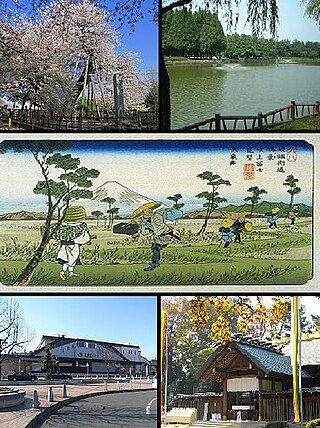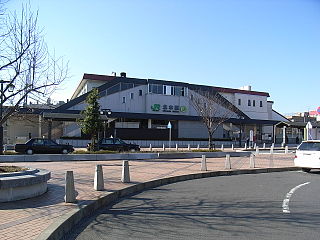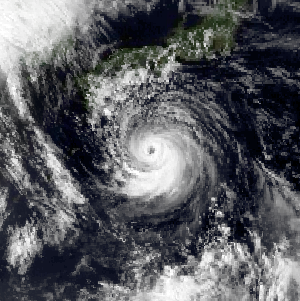Related Research Articles

The 1964 Summer Olympics, officially the Games of the XVIII Olympiad and commonly known as Tokyo 1964, were an international multi-sport event held from 10 to 24 October 1964 in Tokyo, Japan. Tokyo had been awarded the organization of the 1940 Summer Olympics, but this honor was subsequently passed to Helsinki due to Japan's invasion of China, before ultimately being cancelled due to World War II. Tokyo was chosen as the host city during the 55th IOC Session in West Germany on 26 May 1959.

Kitamoto is a city in Saitama Prefecture, Japan. As of 1 January 2021, the city had an estimated population of 66,022 and a population density of 3300 persons per km2. The total area of the city is 19.82 square kilometres (7.65 sq mi).
The 1972 Winter Olympics, officially known as the XI Olympic Winter Games, was a winter multi-sport event held in Sapporo, Japan, from 3 to 13 February 1972. A total of 1,006 athletes representing 35 National Olympic Committees (NOCs) participated in 35 events from 10 different sports and disciplines.

The 1958 Asian Games, officially the Third Asian Games and commonly known as Tokyo 1958, was a multi-sport event held in Tokyo, Japan, from 24 May to 1 June 1958. It was governed by the Asian Games Federation. A total of 1,820 athletes representing 20 Asian National Olympic Committees (NOCs) participated in the Games. The program featured competitions in 13 different sports encompassing 97 events, including four non-Olympic sports, judo, table tennis, tennis and volleyball. Four of these competition sports – field hockey, table tennis, tennis and volleyball – were introduced for the first time in the Asian Games.

Kitamoto Station is a passenger railway station located in the city of Kitamoto, Saitama Prefecture, Japan, operated by East Japan Railway Company.
Kunie Kitamoto is a Japanese football player.
Shinobu Kitamoto is a Japanese sprint canoer who has competed since the mid-2000s. She won a bronze medal in the K-1 200 m event at the 2010 ICF Canoe Sprint World Championships in Poznań, the first person from Japan to medal at the world championships.

Typhoon Prapiroon, known in the Philippines as Typhoon Lusing, was the costliest tropical cyclone to strike the Korean Peninsula and the tenth costliest in the West Pacific on record, as of August 2023.

Typhoon Caitlin, known in the Philippines as Typhoon Ising, contributed to major drought relief in Okinawa. A tropical disturbance formed in the middle of July 1991 in the eastern portion of the Western Pacific monsoon trough, and while tracking to the west-northwest, was designated a tropical depression on July 21. Thunderstorm activity associated with the depression increased markedly on July 22, and two days later, the depression was upgraded into Tropical Storm Caitlin. The storm turned northward as it rounded a subtropical ridge while gradually intensifying. Caitlin became a typhoon on July 25 and peaked in intensity on July 27 near Okinawa. The typhoon began to weaken as it turned northeast over the Korea Strait. On July 30, Catlin transitioned into an extratropical cyclone as it entered the Sea of Japan.
Masamichi is a masculine Japanese given name. Notable people with the name include:
Asumi Ōmura is a Japanese sprint canoeist, born in Shizuoka Prefecture. She won silver and bronze medal in the women's kayak doubles and four at the 2010 Asian Games in Guangzhou, China, respectively. Ōmura is also a member of the canoe and kayak team at Waseda University in Shinjuku, and is coached and trained by Octavian Ispas of Romania.
Masamichi Hayashi is a Japanese footballer who plays for JEF United Chiba.
Kitamoto is a Japanese surname. Notable people with the surname include:

Tropical Storm Winona struck Japan during August 1990. An area of disturbed weather developed within the monsoon trough, located over the East China Sea, on August 4. Despite the presence of strong wind shear, a tropical depression developed later that day. The depression initially tracked northeast, bypassing the southern tip of Kyushu. Thereafter, the depression turned southeast, and on August 6, was believed to have obtained tropical storm intensity. In response to a building subtropical ridge to its southeast, Winona veered north while gradually intensifying. On August 9, Winona peaked in intensity, and while near peak intensity, made landfall in Shizuoka Prefecture early the following morning. Winona transitioned into an extratropical cyclone on August 11, and was last observed on August 14.

Typhoon Zola struck Japan during August 1990. An area of disturbed weather developed during mid-August to the west of Guam. The disturbance developed into a tropical depression on August 16 while tracking eastward. Decreased wind shear aided in intensification, and it is estimated that the depression strengthened into a tropical storm on August 17. Continuing to intensify, Zola turned northwest in response to a subtropical ridge to its east before obtaining typhoon intensity on August 20. Typhoon Zola reached its peak intensity the next day. After weakening slightly, the storm moved ashore on Honshu. On August 23, the system transitioned into an extratropical cyclone over the Sea of Japan.

Severe Tropical Storm Irving, known in the Philippines as Tropical Depression Edeng, was an early-season tropical cyclone that struck southern Japan during August 1992. A distinct but weak low-pressure area developed within the Western Pacific monsoon trough. A tropical depression formed on July 31, and following an increase in both organization and thunderstorm activity, the depression attained tropical storm intensity on the morning of August 2. After tracking west-northwest and then north, Irving turned to the northeast, and attained peak intensity a day later. In response to a subtropical ridge to the north, the system began to track west-northwestward, and made landfall at maximum intensity over southwestern Shikoku at peak intensity. Irving turned sharply to the west and rapidly weakened, dissipating over the Korea Strait at noon on August 5.

Tropical Storm Percy, known in the Philippines as Tropical Storm Miling, was an early-season tropical cyclone that passed through Japan during July 1993. An area of disturbed weather developed in the Philippine Sea on July 26. Gradual development ensued and on July 27, the disturbance was classified as a tropical depression. The following morning, the depression was upgraded into Tropical Storm Percy. Moving north-northwest, Percy slowly deepened and obtained its peak intensity of 115 km/h (70 mph) and a minimum barometric pressure of 975 mbar (28.79 inHg). Late on July 29, Percy passed over Kyushu and began to weaken. Percy was downgraded to a tropical depression on July 30 and dissipated completely two days later.
Ayako Kitamoto is a former Japanese football player and manager. She played for Japan national team.

Tropical Storm Ofelia, known in the Philippines as Tropical Storm Luming, was an early-season tropical cyclone that passed south Japan during July 1993. An area of disturbed weather developed from the Western Pacific monsoon trough in late July 1993. The disturbance organized into a tropical depression on July 24, and the next day developed into a tropical storm. Tracking west-northwestward, Ofelia slowly deepened and attained its peak intensity of 80 km/h (50 mph) and a minimum barometric pressure of 994 mbar (29.4 inHg) at noon on July 26. On the next day, the storm made landfall shortly before weakening to a tropical depression. On July 27, Ofelia transitioned into an extratropical cyclone.
References
- ↑ "日本人親子2代の「韓国愛". JoongAng Ilbo (in Japanese). 12 January 2005. Retrieved 13 May 2020.
- ↑ Evans, Hilary; Gjerde, Arild; Heijmans, Jeroen; Mallon, Bill; et al. "Masamichi Kitamoto Olympic Results". Olympics at Sports-Reference.com. Sports Reference LLC. Archived from the original on 17 April 2020. Retrieved 5 November 2017.